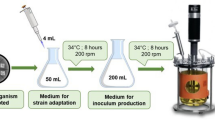Abstract
The addition of 100–300 mmol/L of acetic, propionic, butyric or lactic acids (short-chain acids), or of acetic, propionic, and butyric acids (volatile fatty acids, VFA) mixtures increased the degradation of carboxymethyl cellulose (CMC) byR. albus (7.5 to 46 and 6 to 39%, respectively). Differences among individual acids were observed at 300 mmol/L whereas VFA mixtures differed at 100 mmol/L. When assayed at the same concentration, CMCase activity was increased less by NaCl than by the short-chain acids, whereas ethylene glycol decreased the activity. Since osmolarity and/or ionic strength changes in the medium cannot completely account for the observed increases of carboxymethylcellulase (CMCase) activity, it is suggested that the anions of short-chain acids produce changes in the reaction media polarity that contribute to the effects observed. Alterations in the media could also bring about conformational changes in CMCase leading to increased rates of reaction and subsequent increases in CMC degradation. Finally, explanations for the observed phenomena based on the direct effect of the compounds tested on the cellulosome complex, its domains, and/or its component enzymes are proposed.
Similar content being viewed by others
Abbreviations
- CMC:
-
carboxymethyl cellulose
- CMCase:
-
carboxymethylcellulase
- VFA:
-
volatile fatty acids
References
Attwood G.T., Herreras F., Weissensten L., White B.A.: An endo-β-1,4-glucanase gene (celA) from the rumen anaerobeRuminococcus albus 8: cloning, sequencing, and transcriptional analysis.Can.J.Microbiol. 42, 267–278 (1996).
Barry T.N., Thompson A., Armstrong D.G.: Rumen fermentation studies on two contrasting diets.J.Agric.Sci.Combr.89, 183–195 (1977).
Bradford M.M.: A rapid and sensitive method for the quantitation of microgram quantities of protein utilizing the principle of dye binding.Anal.Biochem. 72, 248–254 (1976).
Caldwell R.D., Bryant M.P.: Medium without rumen fluid for nonselective enumeration and isolation of rumen bacteria.Appl.Microbiol. 14, 794–801 (1966).
Collins K.D., Washabaugh M.W.: The Hofmeister effect and the behaviour of water at interfaces.Quart.Rev.Biophys. 18, 323–422 (1985).
Counotte G.H., Prins R.A.: Regulation of rumen lactate metabolism and the role of lactic acid in nutritional disorders of ruminants.Vet.Sci.Commun. 2, 227–303 (1979).
Dijkstra J.: Production and absorption of volatile fatty acids in the rumen.Livest.Prod.Sci. 39, 61–69 (1994).
Fay J.P., Ovejero F.M.A.: Effect of lactate on thein vitro digestion ofAgropyron elongatum by rumen microorganisms.Anim.Feed Sci.Technol. 16, 161–167 (1986).
Forsberg C.W., Cheng K.-J., White B.A.: Polysaccharide degradation in the rumen and large intestine, pp. 319–379 in R. Onodera, H. Itabashi, K. Ushida, H. Yano, Y. Sasaki (Eds):Rumen Microbes and Digestive Physiology in Ruminants. Japan Sci. Soc. Press, Tokyo-S. Karger, Basel 1998.
Gouws L., Kistner A.: Bacteria of bovine rumen. IV. Effect of change of diet on the predominant type of cellulose-digesting bacteria.J.Agric.Sci. 64, 51–57 (1965).
Hatefi Y., Hanstein W.G.: Solubilization of particulate proteins and nonelectrolytes by chaotropic agents.Proc.Nat.Acad.Sci.USA 62, 1129–1136 (1969).
Hungate R.E.:The Rumen and Its Microbes. Academic Press, New York 1966.
Jalč D., Kišidayová S., Nerud F.: Effect of plant oils and organic acids on rumen fermentationin vitro.Folia Microbiol. 47, 171–178 (2002).
Karita S., Sakka K., Ohmiya K.: Cellulosomes and cellulase complexes of anaerobic microbes: their structure, models and function, pp. 47–57 in R. Onodera, H. Itabashi, K. Ushida, H. Yano, Y. Sasaki (Eds):Rumen Microbes and Digestive Physiology in Ruminants. Japan Sci. Soc. Press, Tokyo - S. Karger. Basel 1998.
Krause D.O., Denman S.E., Mackie R.I., Morrison M., Rae A.L., Attwood G.T., McSweenery C.S.: Opportunities to improve fiber degradation in the rumen: microbiology ecology, and genomics.FEMS.Microbiol.Rev. 27, 663–693 (2003).
Leatherwood J.M.: Ceflulase fromKuminococcus arbus and mixed rumen microorgamms.Appl.Microbiol. 13, 771–775 (1965).
Marounek M., Skřivanova E., Rada V.: Susceptibility ofEscherichia coli to C2-C18 fatty acids.Folia Microbiol. 48, 731–736 (2003).
Morrison M., Miron J.: Adhesion to cellulose byRuminococcus albus: a combination of cellulosomes and Pil-proteins?FEMS Microbiol.Lett. 185, 109–115 (2000).
Miron J., Jacobovitch J., Bayer E.A., Lamed R., Morrison M., Ben-Ghedalia D.: Subcellular distribution of glycanase and related components inRuminococcus albus SY3 and their role in cell adhesion to cellulose.J.Appl.Microbiol. 91, 677–685 (2001).
Ohmiya K., Maeda K., Shimizu S.: Purification and properties of endo-(1,4)-β-d-glucanase fromRuminococcus albus.Carbohydr.Res. 166, 145–155 (1987).
Paggi R.A., Fay J.P.: Effect of short-chain fatty acids on growth of the ruminal bacteriumStreptococcus bovis.J.Gen.Appl.Microbiol. 42, 393–400 (1996).
Paggi R.A., Fay J.P., Fernández H.M.: Effect of short-chain acids and glycerol on the proteolytic activity of rumen fluid.Anim.Feed Sci.Technol. 78, 341–347 (1999a).
Paggi R.A., Fay J.P., Fernández H.M.: Effect of end products of ruminal fermentation onRuminococcus albus growth.Anaerobe 5, 309–311 (1999b).
Pedgen R.S., Larson M.A., Grant R.J., Morrison M.: Adherence of the Gram-positive bacteriumRuminococcus albus to cellulose and identification of a novel form of cellulose-binding protein which belongs to the Pil family proteins.J.Bacteriol. 180, 5921–5927 (1998).
Poole D.M., Hazufwood G.P., Laurie J.I., Barker P.J., Gilbert H.J.: Nucleotide sequence of theRuminococcus albus SY3 endoglucanase genescelA andcelB.Mol.Gen.Genet. 223, 217–223 (1990).
Roger V., Fonty G., Andre C., Gout P.: Effects of glycerol on the growth, adhesion, and cellulolytic activity of rumen cellulolytic bacteria and anaerobic fungi.Curr.Microbiol. 25, 197–201 (1992).
Russell J.B., Diezgonzález F.: The effects of fermentation acids on bacterial growth.Adv.Microbiol.Physiol. 39, 205–234 (1998).
Smith W.R., Yu I., Hungate R.F.: Factors affecting cellulolysis byRuminococcus albus.J.Bacteriol. 89, 1169–1175 (1973).
Stack R.J., Hungate R.E.: Effect of 3-phenylpropanoic acid on capsule and cellulases ofRuminococcus albus 8.Appl.Environ.Microbiol. 48, 218–223 (1984).
Stack R.J., Hungate R.E., Opsahl W.P.: Phenylacetic acid stimulation of cellulose digestion byRuminococcus albus 8.Appl.Environ.Microbiol. 46, 539–544 (1983).
Wood T.M., Bhat M.: Methods for measuring cellulase activities.Meth.Enzymol. 160, 87–112 (1988).
Wood T.M., Wilson C.A., Stewart C.S.: Preparation of the cellulase from the cellulolytic anaerobic bacteriumRuminococcus albus and its release from the bacterial cell wall.Biochem.J. 205, 129–137 (1982).
Author information
Authors and Affiliations
Corresponding author
Additional information
The second author was a career researcher at theConsejo Nacional de Investigaciones Cientificas y Técnicas de la Republica Argentina (CONICET). This research was partly supported by grants from theUniversidad Nacional de Mar del Plata and the Comisión de Investigaciones Cientificas de la Provincia de Buenos Aires (CIC).
Rights and permissions
About this article
Cite this article
Paggi, R.A., Fay, J.P. Effect of short-chain acids on the carboxymethylcellulase activity of the ruminal bacteriumRuminococcus albus . Folia Microbiol 49, 479–483 (2004). https://doi.org/10.1007/BF02931612
Received:
Revised:
Published:
Issue Date:
DOI: https://doi.org/10.1007/BF02931612




